Navigate This Post
There are guns for fun and guns for fighting. Canik pistols are built for fighting. For the last five years or so I have been working with the modern incarnations of the Canik pistol line. The first version that I had the opportunity to work with was the TP9SA. Since that first experience, I have evaluated and carried several models of Canik pistol. Let’s take a moment to examine the various handguns and how we may use them.
TP9SA Mod.2 9x19mm Duty Size Pistol
Canik Pistols – TP9SA
It all began with my introduction to the TP9SA. This 9x19mm NATO pistol thoroughly impressed me. As a matter of fact, I was so taken with this Canik pistol that I ordered a Crossbreed SuperTuck holster for it. I started toting the gun as an EDC (everyday carry) pistol.
I discovered through serious range use and training that the TP9SA was a quite well-made and robust gun. The pistol fed and consumed every style and type of 9mm ammunition that I fed it. Without fail, regardless of bullet design or case material, the Canik pistol fed, fired, and ejected all the 9mm ammo I ran through it.
Century Arms, the exclusive importer and distributor of the Canik pistol line in the United States, shipped that first pistol. It came with two magazines and a polymer holster in a hard plastic case. Like all modern striker-fired, polymer-framed handguns, they include an M1913 accessory rail on the frame.
The TP9SA answered the complaint that many shooters had about striker-fired handguns. The need to press the trigger to disassemble the gun.
Decocking
The SA has a slide-mounted decocker that takes the spring tension off of the striker, allowing the removal of the slide. I trained with and carried the gun for two years, never once did the gun “accidentally” decock.
One of the biggest complaints that the end-users had about the first TP9SA was the fact that the sights were proprietary. They could not be easily swapped out for better versions. Most serious self-defense shooters prefer a bright, Tritium front sight.
Century Arms has since released a TP9SA Mod.2 version of the gun with dovetailed front and rear sights. Now the end-user, if they so choose, can spend the extra money and install aftermarket Tritium sights. Night Fision sights happen to have several excellent choices in that regard. Factory sights are from Warren Tactical.
During the first year or so that the TP9SA was available, I was able to test and evaluate several pistols. All told, I launched in the neighborhood of 1000 to 1500 rounds through the guns and gained a solid respect for them as being Rhino tough.
A TP9SF model got released a couple of years after the SA. However, The SF does not have the slide-mounted decocker. You must press the trigger on an empty chamber to release the striker spring tension for disassembly.
CLICK HERE to apply to be part of The Student Lounge.
TP9SFX Competition Ready 9x19mm Pistol
Canik Pistols – TP9SFX
Century Arms, in a bid to gain some of the competition crowd, released the TP9SFX model. One of the hallmarks of the TP9 series is the excellent striker-fired trigger. People who try these pistols for the first time are often surprised at how good the trigger feels on such an inexpensive gun.
As far as accuracy goes, the barrels are NATO spec. The guns, when held steady, will put rounds after round after round right on top of each other with boring monotony. It is easy to say that the gun has more accuracy potential than ninety-nine percent of the hands that hold them.
FEATURES
The features that make the TP9SFX unique include a 5.2″ match barrel and long slide, two 20 round mags, and interchangeable back-straps. The slide is optic ready and the pistol comes with an optic kit. It includes four different types of mounting plates to accommodate the various models of mini-red dot sights. This Canik pistol also comes with a dedicated holster, cleaning kit, and mag loading tool, all inside a padded hard case.
I installed a Leupold DeltaPoint mini-red dot sight on the SFX version that I picked up. The optic was easy to zero and once I had it tuned to fifteen yards, I was ringing steel plates like no one’s business. The only downside to the SFX is that it is such a pleasure to shoot that you will need to purchase a lot more ammunition. By the time I finished my first range session with the gun, over 200 pieces of empty 9mm brass littered the range at my feet.
Century Arms offers the stock TP9SFX at an MSRP of right around $550. They also offer a model that comes equipped with a Vortex Viper mini-red dot for an MSRP of $825. Either version is a great deal for an out of the box, match ready pistol.
TP9SF Elite; Small enough to carry, Big enough to fight
Canik Pistols – TP9SF Elite
For those who have said, “I like the TP9 pistol, but it’s too big for concealed carry.” Century Arms and Canik introduced the TP9SF Elite version. The Elite is “small enough to carry, but big enough to fight” with. This is the best of both worlds. The first offering of the Elite pistol features a Tungsten grey slide mated to a black polymer frame. The barrel length is 4.19 inches and the slide length is 7.28 inches.
The more compact frame gives the Canik SF Elite a height of 5.27 inches compared to 5.70 inches on the full-sized SF. Also, by comparison, the original SF has a 4.46 inch barrel and an overall length of 7.55 inches. Empty weight for the SF Elite is 1.77 pounds and the standard magazine capacity is 15 rounds, five rounds less for tax slaves.
NATO Standards
While available for the US market, they designed & built the TP9SF Elite to pass NATO military standards. It had to undergo stringent durability tests before going into full production. The Elite pistol had to pass a tough “Dirt, Sand, and Mud Test” and still keep running. We took our first Elite pistol to the range and buried it in the powder-like sand of coastal Mississippi. The gun ran like a champ. As expected, the Elite consumed every type of 9x19mm ammunition we fed it; steel, aluminum, brass, and nickel casings.
With the success of the original Elite pistol, Century Arms introduced three more models. The “One Series” version of the Elite is a price point model, no bells or whistles. It is a solid, compact pistol. They have the Elite Combat model that has a match factory-threaded barrel with a 13.5x1mm LH thread pitch. The Combat has a red dot optic ready slide, match-grade trigger, and extended magazine. To make it stand out, they coated the combat model in a Flat Dark Earth color.
The latest TP9SF Elite model is the “Executive” version. The Executive version is black with a distinctive gold match barrel. Again, the barrel is factory threaded, but this time the thread pitch is US standard 1/2×28 TPI. Included is an extended capacity magazine along with a flush 15 rounds magazine. I should mention that Century Arms also offers the Elite Combat pistol with a Vortex Viper red dot.
TP9SF Elite Subcompact; Discreet Concealed Carry
Canik Pistols – TP9SF Elite Subcompact
In yet another case of, “give the customer what they want”, Canik and Century Arms released the newest member of the TP9 pistol series. The TP9SF Elite Subcompact. The Subcompact, or simply SC for short, fits the deep concealed carry desire of many customers. They asked for a pistol that was small enough for discreet concealed carry, yet still had the size and capacity to be an effective fighting tool.
The SC has a slide length of 6.7 inches and a barrel length of 3.6 inches. The overall height is 4.6 inches and the width is 1.45 inches. A flush magazine holds 12 rounds and their extended floorplate magazine holds 15 rounds. Both come standard with the pistol. For those who have either the full-sized SF or the Elite model, the longer magazines will fit and operate in the SC, a big plus for training.
The SC looks similar to the Elite as it has a Tungsten grey slide and black polymer frame. You will find the same superb trigger as the SA, SF, and Elite in the Subcompact model. Despite having a shorter sight radius, the pistol is capable of truly respectable accuracy. As long as the shooter does their job, the SC will put all 12 or 15 rounds into a large ragged hole at 10 yards. Again, sights from the factory are steel Warren Tactical versions. I chose to install a Night Fision Tritium front sight on my gun and leave the black steel factory rear sight. Zero was not affected.
Comfortable?
Is the SC as comfortable to shoot as the full-sized SF or SA? No, not really. Felt recoil is a bit more noticeable with the SC than the bigger guns. That is the reality of physics or ballistic science. But, the SC is manageable, even when shooting with just the strong hand or the support hand only. Also, I found that the Canik Elite Subcompact pistol was reliable with all the ammunition that I fed it.
One unique feature of the TP9SF Elite Subcompact is the red dot ready slide. Unlike the larger SFX and Elite Combat models that utilize adapter plates for various style red dots, the SC is designed for one specific style of red dot; the Shield Sights mini-red dot. You can add your own Shield red dot or buy an SC that comes from Century Arms with a Shield red dot already installed.
TP9SF Elite Combat in distinctive FDE finish is red dot ready
Canik Pistols – TP9DA
As has been their habit, Canik and Century Arms do their best to please a wide array of gun owners and purchasers. Enter the TP9DA, a gun for people who like their lives to be a bit more complicated.
The Canik TP9DA is a reversion back to the trigger design made popular 20+ years ago by the Walther P99 and later S&W99. The Double Action has a two-stage trigger; the first shot is a long, striker-cocking motion with successive trigger presses being lighter single-action.
For my range testing, I engaged steel reactive targets at various distances. I would operate the pistol using both the decocked striker and engaged striker. Ammunition used in the evaluation was a mix of Black Hills 124g. JHP, Nosler 115 JHP, Winchester “Forged” steel case 115 FMJ, Federal aluminum case 115g FMJ, Perfecta brass case 115g. FMJ and CorBon DPX 115g. HP.
I fired the DA pistol from two-hand hold with a dominant right hand, right hand only, left hand only, and two-handed using the left hand as dominant. Drills began with the TP9DA pistol in the decock mode in the Canik holster that came with the pistol. I utilized both of the 18 rounds magazines supplied with the pistol, along with other full capacity TP9 magazines.
Zero Malfunctions
The Canik TP9DA pistol experienced zero (0) stoppages or malfunctions during the initial testing phase. Every magazine locked the slide to the rear on empty. I dropped the magazines on the ground during reloading sequences. All drills began with a round chambered and a full 18 round magazine inserted.
From a distance of 15 meters, rounds were impacting approximately one to two inches above the hold of the front sight point. Windage was zeroed exactly left and right from the factory.
As for the overall profile, the TP9DA is essentially the same size as the TP9SF. The DA has a slide-mounted decocking button, to allow the user to decock the striker after a chambering a round or after a string of shooting. The trigger on the DA is not horrible, but it does have a learning curve. It is nowhere near as crisp and smooth as the SA, SF, or the Elite. If you absolutely must have a long, heavy first trigger press, but you want a gun that is rhino tough and won’t quit, the TP9DA is a valid option.
Professor Paul Markel
Latest posts by Professor Paul Markel (see all)
- Tactical Masturbation: Top 3 Stupid Human Tricks - July 8th, 2024
- Blood Trail: Fearless Fiction - June 21st, 2024
- SOTG and SB Tactical Celebrate Brace Ruling - June 20th, 2024
- Shotgun Accessories: Practical and Useful - June 14th, 2024
- Tactical Rifle Tips: Transition Drills - January 5th, 2024
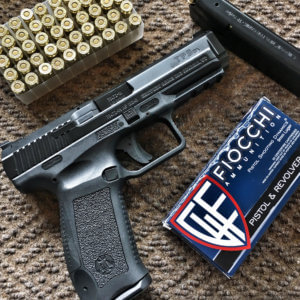
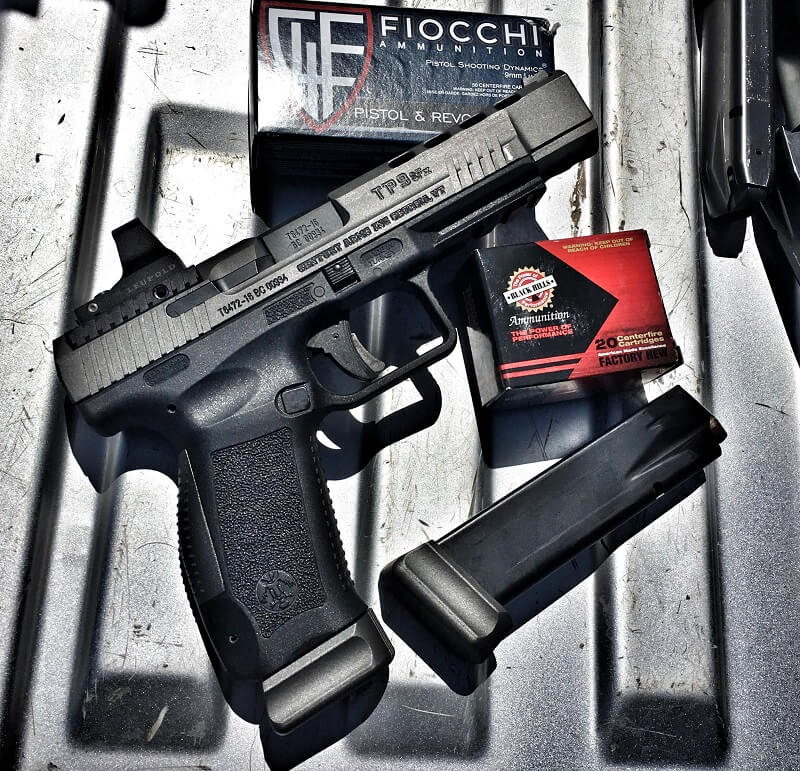
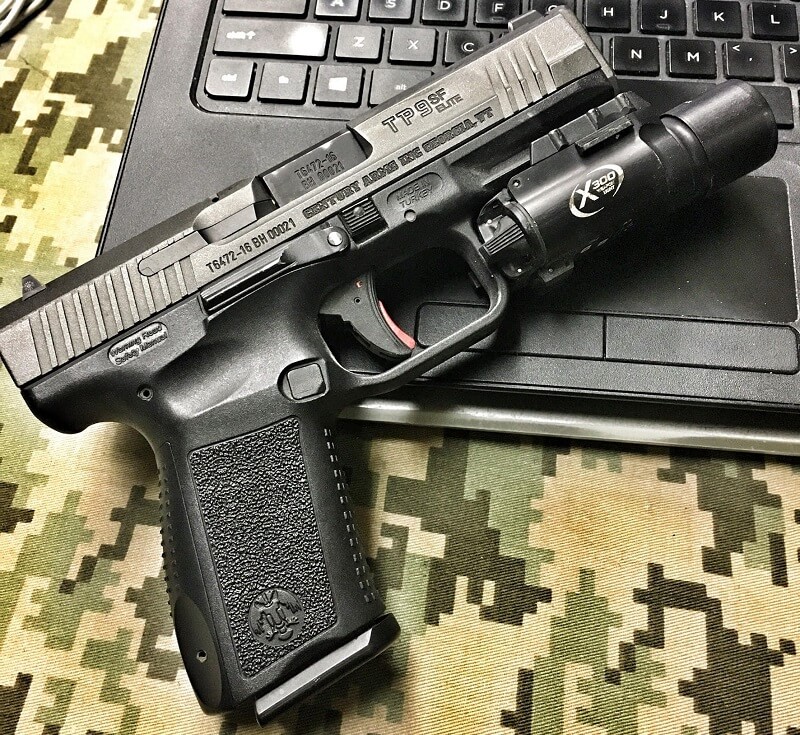
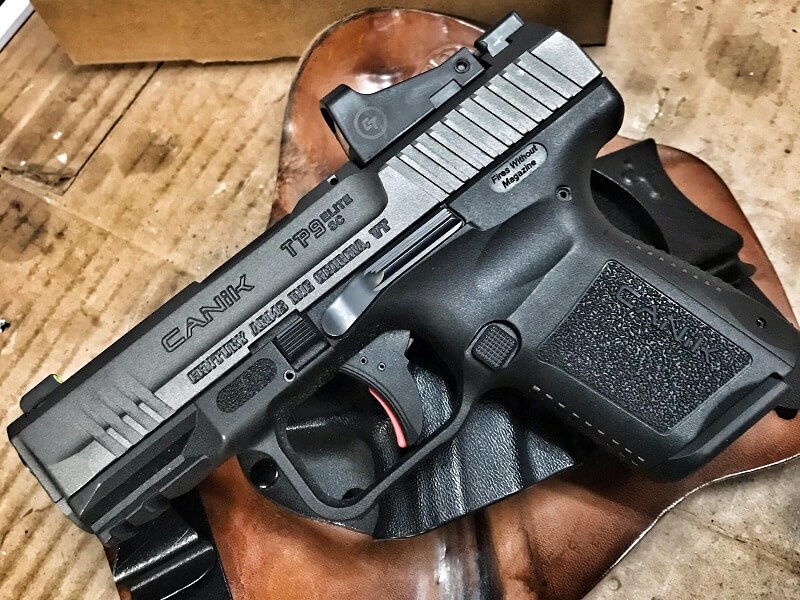
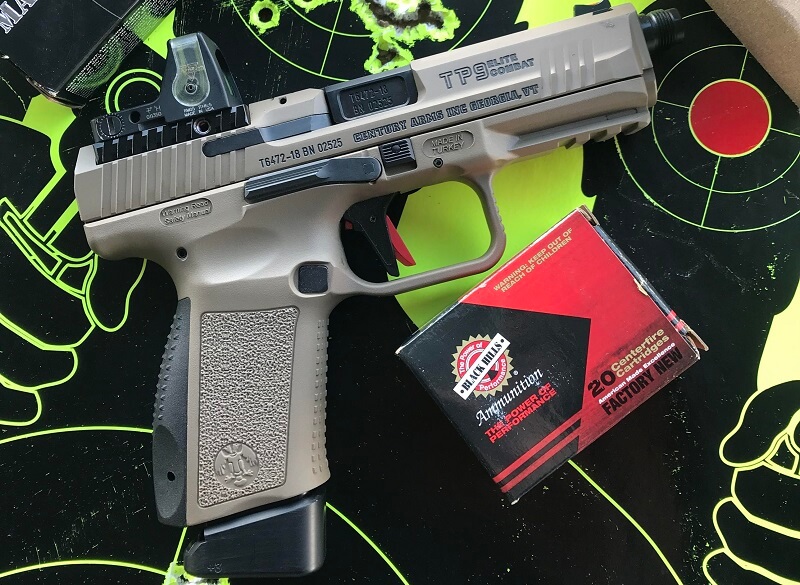






Just recently purchased the TP9SC Elite. Only shot it once so fare I do love the trigger. I really, really want to get the TP9SFx as well and try it out for some competitive shooting.
That sounds fun. I love the SC!
What red dot is on that elite sc?
Hi Travis. That’s the CTS 1500 from Crimson Trace. You can’t buy that model but they have others.
Bought a TP9 elite combat and carried it on duty as a rural sheriff deputy for a couple of weeks. Carried in a blackhawk omnivore holster with a streamlight TLR-1 because it was the only retention holster setup I could find to fit it. The edges of the light rail sheared off and the light canted to about a 10 degree angle. Apparently the angle of the edge of the rail isnt exactly the same geometry as a standard 1913 rail so it only engages on the very edge. Century is replacing the gun but its a quirk with an otherwise awesome little gun. I used the exact same setup for a polymer framed 1911 for a couple of years with no issues, but the canik had damage in 2 weeks.